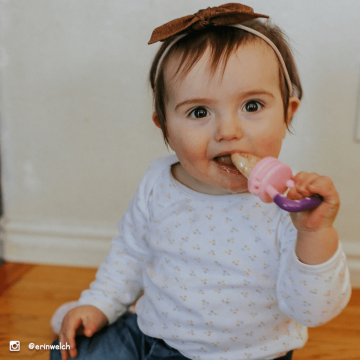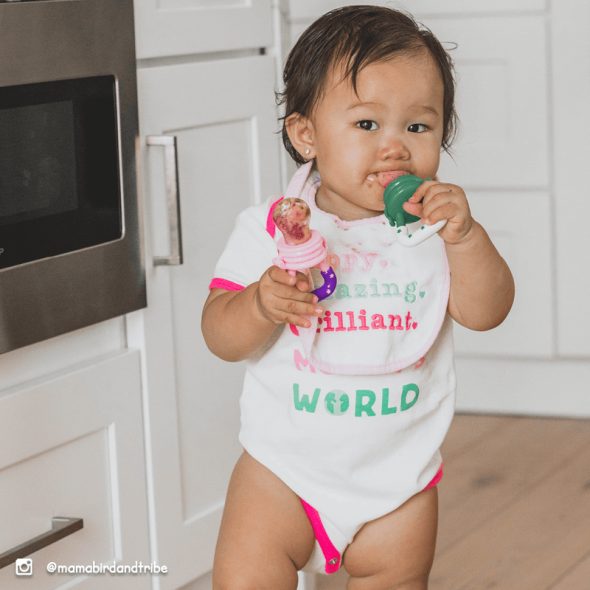
Starting solids is an exciting time for you and your baby. It is one of the milestones in their development and your parenting. There are so many choices to make regarding which foods to give and how to feed them, but the one thing that can make the process a little easier is a baby fruit feeder pacifier.
In this post, we’ll share tips on using a baby fruit feeder pacifier, the benefits of using one, and the characteristics of the best one. So, whether you’re just starting your baby on solids or are looking for new ways to get your baby interested in food, read on for our full guide!
Benefits of Using a Fruit Feeder Pacifier
There are various ways to introduce solids to your little one. You can let them rely on you through spoon feeding or allow them to enjoy soft baby food and biscuits using their hands. You can utilize different baby utensils like baby spoons and forks, suction bowls and plates, and sippy cups. But why choose a feeder pacifier? Check out these benefits!
Helps the transition from breast/formula feeding to solids
Babies are used to suckling as they feed on breastmilk or formula milk. A pacifier can help them transition from suckling to slowly eating solids. These pacifiers are designed with multiple holes allowing babies to suckle on juices and eat fresh fruit or vegetables.
Allows your baby to experience flavors
Feeding through a pacifier also introduces different flavors without risking your baby making a mess by spitting up food they do not like. Add grapes, apples, bananas, potatoes, mangoes, and sweet potatoes! When your little one begins eating full meals, they’ll surely recognize the flavors.
Provides safety when eating
Choking is one of the worries of parents like you. Babies put anything they hold into their mouths, including food. The design of baby feeder pacifiers only allows small bits of food to pass through, keeping this hazard at bay.
Eases teething
Aside from food safety, feeding pacifiers also fulfill the purpose of baby teethers. You can add frozen food inside the pacifier, which helps ease the pain teething babies experience. The friction in chewing the silicone nipple helps alleviate your baby’s discomfort. There are also baby food feeder pacifiers that are teether-friendly. The handles have holes where you can attach the teether, so your little one can have another toy to bite and chew on.
Can keep babies busy
Babies are filled with energy. Suppose you are eating together and are done feeding them their meals; chances are they may become fussy and want to leave their high chairs. Let them suckle on frozen fruit or dessert inside a food pacifier to keep them busy while you finish your meal.
Encourages feeding independence
Allowing your baby to hold onto their food and feed themselves even in this simple way of using a feeder pacifier encourages independence. This method is way better than spoon feeding them. As they grow, introduce new utensils to them and guide them on their proper use.

A Guide to Using A Baby Fruit Feeder
Do the benefits of feeder pacifiers sound enticing? If you think this feeding tool is suitable for your little one and want them to reap its benefits, you can try it. Here’s how to use it and a few reminders to make the most of it to help your baby’s development.
Step by Step Guide
- Prepare your choice of solid food. You can puree fruits and vegetables and freeze them before putting them in the pacifier. You can also put in some yogurt and other mashed treats.
- Put your choice of food in the pacifier and keep the seal tight. Ensure your baby cannot open it to avoid the risk of choking.
- Let your baby independently feed on the pacifier and enjoy the treat.
- After suckling, remove the remaining food.
- Clean the pacifier using soap and warm water, and let it dry.
A Few Reminders
- Not wasting food is a good practice to teach to your child, but saving leftovers inside the pacifier shouldn’t be one of them. Letting the leftovers stay inside the pacifier can cause bacteria to form, which may make your baby sick.
- Although pacifiers can keep your baby busy, do not let this be their activity to fight boredom during their free time. This keeps them from doing more productive activities, and can teach them bad habits.
- Plan when you’ll wean your baby from using a pacifier feeder. This feeder is best for introducing food, but you should also begin introducing bowls, spoons, forks, and other utensils to them too.
- Although a baby food feeder has food inside, it shouldn’t be your baby’s main meal. It can be used for snacks or desserts, but you still need to prepare a full meal for them.
Characteristics of the Best Food Pacifier
When out in the market to scout and purchase food pacifiers, you’ll notice that they come in different designs. Some fruit pacifiers mimic the look of a regular pacifier but are bigger and have more holes. Some are made with a mesh feeder instead of silicone nipples. These designs allow food to go through the gaps.
Despite the different designs, these general characteristics make a food-grade fruit feeder pacifier a great choice:
- Free from BPA, phthalates, formaldehyde, and other chemicals harmful for babies.
- Has just the right hole size for small food portions to pass through.
- Has a baby-friendly color or design to encourage babies to use it.
- Easy to clean.
You may initially go through trial and error and purchase two or more pacifiers—this is normal. What matters is you get the food pacifier that fits your little one best.

Ashtonbee’s Baby Fruit Feeder Pacifier
So there you have it, our comprehensive guide to starting your baby on solids using a fruit feeder pacifier. We hope that you found this information helpful, and that it has eased some concerns you may have about transitioning from breast milk or formula feeding to solids. Remember, start with simple fruits like banana, apple, or pear and watch for signs of readiness before trying anything more adventurous. Don’t forget, Ashtonbee’s baby fruit feeder pacifiers make starting your little one on solids easier and more fun! Check it out, and get one now!



